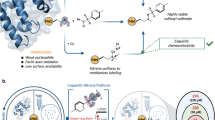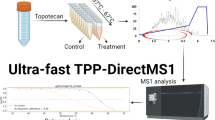Peptide KE exhibits immunoprotective, geroprotective, and oncostatic activities and stimulates functional activity of fibroblasts. The KE motif is present in amino acid sequences of some cytokines and peptide hormones functionally similar to KE peptide. However, the relationship between the presence of KE motif and protein functions on the scale of known human proteome has not yet received sufficient attention. The incidence of bioregulatory peptide KE in proteins of various functional groups constituting human proteome is studied. The study is carried out with the use of the available data on the human proteome (UniProt portal) comprising 20,417 proteins. The levels of KE motifs were maximum in cytoplasmic and nuclear proteins, while the presence of KE in the membrane and all other proteins was the minimum. KE peptide molecules released from nuclear proteins during limited proteolysis can bind to DNA and regulate gene expression.
Similar content being viewed by others
References
Kuznik BI, Khavinson VKh, Linkova NS, Ryzhak GA, Sall TS, Trofimova SV. Growth Factors of Fibroblasts FGF19, FGF21, FGF23 as Endocrine Regulators of Physiological Functions and Geroprotectors. Epigenetic Regulatory Mechanisms. Uspekhi Sovremen. Biol. 2017;137(1):84-99. Russian.
Kuznik BI, Khavinson VKh, Tarnovskaya SI, Linkova NS, Kozina LS, Dyakonov MM. Adhesion molecule JAM-A, its function and mechanism of epigenetic regulation. Uspekhi Gerontol. 2015;28(4):656-668. Russian.
Lin’kova NS, Polyakova VO, Trofimov AV, Kvetnoy IM, Khavinson VKh. Peptidergic regulation of thymocyte differentiation, proliferation, and apoptosis during aging of the thymus. Bull. Exp. Biol. Med. 2011;151(2):239-242.
Raikhlin NT, Bukaeva IA, Smirnova EA, Yarilin AA, Sharova NI, Mitneva MM, Khavinson VKh, Polyakova VO, Trofimov AV, Kvetnoi IM. Expression of argyrophilic proteins in the nucleolar organizer regions of human thymocytes and thymic epitheliocytes under conditions of coculturing with vilon and epithalon peptides. Bull. Exp. Biol. Med. 2004;137(6):588-591.
Sevostianova NN, Linkova NS, Polyakova VO, Chervyakova NA, Kostylev AV, Durnova AO, Kvetnoy IM, Abdulragimov RI, Khavinson VH. Immunomodulating effects of Vilon and its analogue in the culture of human and animal thymus cells. Bull. Exp. Biol. Med. 2013;154(4):562-565.
Fedoreyeva LI, Dilovarova TA, Martirosyan YT, Kharchenko PN, Vanyushin BF, Ashapkin VV, Khavinson VK. Short exogenous peptides regulate expression of CLE, KNOX1, and GRF family genes in Nicotiana tabacum. Biochemistry (Moscow). 2017;82(4):521-528.
Fedoreyeva LI, Vanyushin BF, Kireev II, Khavinson VKh. Penetration of short fluorescence-labeled peptides into the nucleus in HeLa cells and in vitro specific interaction of the peptides with deoxyribooligonucleotides and DNA. Biochemistry (Moscow). 2011;76(11):1210-1219.
Khavinson VK, Anisimov VN, Zavarzina NY, Zabezhinskii MA, Zimina OA, Popovich IG, Shtylik AV, Malinin VV, Morozov VG. Effect of vilon on biological age and lifespan in mice. Bull. Exp. Biol. Med. 2000;130(7):687-690.
Khavinson VKh, Lezhava TA, Malinin VV. Effects of short peptides on lymphocyte chromatin in senile subjects.. Bull. Exp. Biol. Med. 2004;137(1):78-81.
Khavinson VK, Morozov VG, Malinin VV, Kazakova TB, Korneva EA. Effect of peptide Lys-Glu on interleukin-2 gene expression in lymphocytes. Bull. Exp. Biol. Med. 2000;130(9):898-899.
Khavinson VKh, Tarnovskaya SI, Linkova NS, Pronyaeva VE, Shataeva LK, Yakutseni PP. Short cell-penetrating peptides: a model of interactions with gene promoter sites. Bull. Exp. Biol. Med. 2013;154(3):403-410.
Shcherbak VA, Pateyuk AV. Vilon influence on immune response in acute immobilization stress in rats. Sib. Med. Zh. (Irkutsk). 2004;44(3):26-29. Russian.
Anisimov VN, Khavinson VKh. Peptide bioregulation of aging: results and prospects. Biogerontology. 2010;11(2):139-149.
Caputi S, Trubiani O, Sinjari B, Trofimova S, Diomede F, Linkova N, Diatlova A, Khavinson V. Effect of short peptides on neuronal differentiation of stem cells. Int. J. Immunopathol. Pharmacol. 2019;33. doi: https://doi.org/10.1177/2058738419828613
Khavinson VKh, Malinin VV. Gerontological Aspects of Genome Peptide Regulation. Basel, 2005.
Author information
Authors and Affiliations
Corresponding author
Additional information
Translated from Byulleten’ Eksperimental’noi Biologii i Meditsiny, Vol. 168, No. 11, pp. 569-572, November, 2019
Rights and permissions
About this article
Cite this article
Terekhov, A.Y., Kormilets, D.Y., Linkova, N.S. et al. Peptide KE in Human Proteome. Bull Exp Biol Med 168, 631–633 (2020). https://doi.org/10.1007/s10517-020-04767-z
Received:
Published:
Issue Date:
DOI: https://doi.org/10.1007/s10517-020-04767-z




